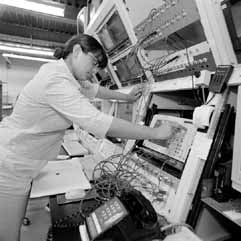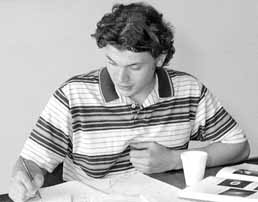 |
|
Interns Share a summer to remember by Mike Perricone
For an undergraduate, a summer of hands-on experimental work can start a career like this one: B.S. in Physics and Mathematics, U. of Kansas; Ph.D. in Physics, U. of Wisconsin; NSF Graduate Fellow, U. of Wisconsin; Sherman Fairchild Postdoctoral Scholar in Theoretical Physics, CalTech; David N. Schramm Research Fellow in Theoretical Astrophysics, Fermilab.
"When I was an undergraduate, I knew that I wanted to be a theorist," said Fermilab's John Beacom, who served summer internships at Argonne, Fermilab and the Institut Laue-Langevin in Grenoble, France. "But I thought that I should first see how the other half lives, since physics is fundamentally a science of measurement. And that exposure to research really enlarged my perspective, and convinced me that I wanted to continue in physics."
Friendships grow along with careers. Beacom also counts three close friends from that IPM summer who have built careers in the field: astronomers Geoff Bower and John Monnier, and Nima Arkani-Hamed of extra dimensions fame.
Fermilab's internship program dates back two decades, instituted by the now-retired Drasko Jovanovich, who also founded Saturday Morning Physics for high school students. Fermilab physicist Roger Dixon carries on the double-duty tradition, coordinating Saturday Morning Physics and sharing IPM duties with physicist Erik Ramberg, along with administrator Maxine Hronek.
Dixon sees the interns as an investment in the future.
"After the Snowmass conference [on the future of particle physics], the kids had a continuing e-mail dialogue on where they thought the field should be heading," Dixon said. "In some ways, their discussion might even be more important than what went on at Snowmass. These kids are the future of the field."
This summer's 15 interns represent the pick of 200 applicants, who submit essays on their interests and hopes, along with references and academic records. Dixon and Ramberg endure what they describe as near-heartache in culling the list, but their goal is a diverse group as well as outstanding students. Ramberg says "enthusiasm is one of the biggest criteria," and Dixon points out that Harvard doesn't necessarily outrank Joliet Junior College--in fact, Joliet JC (Chris Lesher) is represented this summer, and Harvard is not.
The interns do real work on real experiments, and receive real pay (approximating the level of other lab employees with similar experience). Hronek arranges living quarters in nearby apartment complexes, deducting rent from their paychecks. The group meets weekly for informal lectures on physics topics, and the summer concludes with a presentation from each student on the summer's work. But Dixon, Ramberg and Hronek all stress that the "off-duty" experience is equally important, and it shows in the students' assessments of their experience.
"Due in part to the multilingual and multicultural diversity of our group," says Paretz Partensky of Brandeis University, who was born in Russia, "we sometimes transform into a UN-like forum of political discussions, many of which lead us to meet dawn from the wrong side."
Angelique Talbot of St. Andrews University in Scotland concludes: "We have been made to feel so welcome and special by everyone that I would recommend an internship to every physics student--if only for that one conversation at 2 a.m. on Life, The Universe, and everything else that makes it all worthwhile."
Matt Rakher, University of Illinois at Urbana-Champaign: Worked with physicists Bob Tschirhart, Erik Ramberg and Hogan Nguyen on simulation studies for the CKM detector. "My summer here has enabled me to learn a good deal of introductory particle physics, and to see how much work goes into an experiment even before anything gets built. The interns, physicists, engineers and everyone else I have worked with at Fermilab have been very helpful, and I can only hope the relationships I have forged here will last for years to come."
|
| last modified 8/11/2001 by C. Hebert email Fermilab |
FRLsDFx9eyfrPXgV
 Summer is the season for the growth--in the case of Fermilab's Internships for Physics Majors program, a season for the growth of careers.
Summer is the season for the growth--in the case of Fermilab's Internships for Physics Majors program, a season for the growth of careers.
 Marie Lopez del Puerto, Universidad de las Americas, Puebla, Mexico: Chosen for IPM by Particle and Fields Division of Mexican Physics Society. Worked on DZero's Central Fiber Tracker with physicists Don Lincoln, Andrew Alton and John Anderson. "What I've found most impressive is the general atmosphere at Fermilab, the excitement when something is made to work and when new results are published, how laid-back and helpful everyone is, and how much effort everyone puts in to make such a big collaboration work successfully."
Marie Lopez del Puerto, Universidad de las Americas, Puebla, Mexico: Chosen for IPM by Particle and Fields Division of Mexican Physics Society. Worked on DZero's Central Fiber Tracker with physicists Don Lincoln, Andrew Alton and John Anderson. "What I've found most impressive is the general atmosphere at Fermilab, the excitement when something is made to work and when new results are published, how laid-back and helpful everyone is, and how much effort everyone puts in to make such a big collaboration work successfully."
 Fermin Reygadas, Leon Lederman Award, Hertell Foundation, Universidad Nacional Autonoma de Mexico: Worked on BTeV. "Because it is an experiment still under development, I have been able to see how all the pieces of the detectors are designed, tested, redesigned, tested, redesigned. It's great that the internship is designed for students in the middle of college, letting us share what we have learned with our classmates back at school...the impact on science and education goes beyond the individual level."
Fermin Reygadas, Leon Lederman Award, Hertell Foundation, Universidad Nacional Autonoma de Mexico: Worked on BTeV. "Because it is an experiment still under development, I have been able to see how all the pieces of the detectors are designed, tested, redesigned, tested, redesigned. It's great that the internship is designed for students in the middle of college, letting us share what we have learned with our classmates back at school...the impact on science and education goes beyond the individual level." Lauren Tompkins, University of California-Berkeley: Worked with physicist Gina Rameika on DONUT, setting up public-interest website and analyzing data. "Sitting in on HEPAP subpanel talks, attending press conferences after the release of the first SNO results, hearing all the gossip coming out of SnowmassÖ seeing textbook lessons on the Standard Model manifesting themselves as calorimeter readings or scintillator hitsÖ have all given me an introduction to the physics world that I don't think I could get anywhere else. I'm also working with an amazing group of people, who are going to be my friends for life."
Lauren Tompkins, University of California-Berkeley: Worked with physicist Gina Rameika on DONUT, setting up public-interest website and analyzing data. "Sitting in on HEPAP subpanel talks, attending press conferences after the release of the first SNO results, hearing all the gossip coming out of SnowmassÖ seeing textbook lessons on the Standard Model manifesting themselves as calorimeter readings or scintillator hitsÖ have all given me an introduction to the physics world that I don't think I could get anywhere else. I'm also working with an amazing group of people, who are going to be my friends for life."
 Angelique Talbot, St. Andrews University, Scotland: Worked with physicist Helen Edwards on AZero Photoinjector, investigating superconducting TESLA cavity. "I never expected the experiments to be so much fun--especially when trusted to turn on all the RF systems myself, ignoring the motto, `Never let a theorist play with your accelerator.' I love walking into an office and asking, `Can you explain this?' and receiving such an enthusiastic response. The part of the project that was most satisfying, though, was being able to complete analysis of my own data, and to make conclusions from it."
Angelique Talbot, St. Andrews University, Scotland: Worked with physicist Helen Edwards on AZero Photoinjector, investigating superconducting TESLA cavity. "I never expected the experiments to be so much fun--especially when trusted to turn on all the RF systems myself, ignoring the motto, `Never let a theorist play with your accelerator.' I love walking into an office and asking, `Can you explain this?' and receiving such an enthusiastic response. The part of the project that was most satisfying, though, was being able to complete analysis of my own data, and to make conclusions from it."
 Federico Gallo, Kings College, London: Worked in PPD with physicist Ryuji Yamada. "Under the direct supervision of Dr. Yamada, my goal is to obtain a more precise value for the mass of the top quark. In the process, I am learning about the specifics of the creation of top quarksÖ I see this experience as an opportunity to look at the x-ray of the skeleton of fundamental physics, a chance to unveil its most intimate secrets in the attempt to convince myself that this science is the true intellectual love of my life. Or else."
Federico Gallo, Kings College, London: Worked in PPD with physicist Ryuji Yamada. "Under the direct supervision of Dr. Yamada, my goal is to obtain a more precise value for the mass of the top quark. In the process, I am learning about the specifics of the creation of top quarksÖ I see this experience as an opportunity to look at the x-ray of the skeleton of fundamental physics, a chance to unveil its most intimate secrets in the attempt to convince myself that this science is the true intellectual love of my life. Or else."
 Paretz Partensky, Brandeis University: Worked with astrophysicist Jim Annis on the Sloan Digital Sky Survey, studying the large-scale structure of the universe. "We are working on algorithms that will automate the identification of new galaxy clusters and verification of old clusters. This task involves painstaking programming in multiple computer languages and going to meetings where we drink enormous amounts of coffee. This experience has demonstrated my personal comfort with research and consequently boosted my confidence. I want to thank Fermilab not only for advancing my physics knowledge, but also for making me aware of the truly amazing friendship possibilities in our very diverse group of individuals."
Paretz Partensky, Brandeis University: Worked with astrophysicist Jim Annis on the Sloan Digital Sky Survey, studying the large-scale structure of the universe. "We are working on algorithms that will automate the identification of new galaxy clusters and verification of old clusters. This task involves painstaking programming in multiple computer languages and going to meetings where we drink enormous amounts of coffee. This experience has demonstrated my personal comfort with research and consequently boosted my confidence. I want to thank Fermilab not only for advancing my physics knowledge, but also for making me aware of the truly amazing friendship possibilities in our very diverse group of individuals."